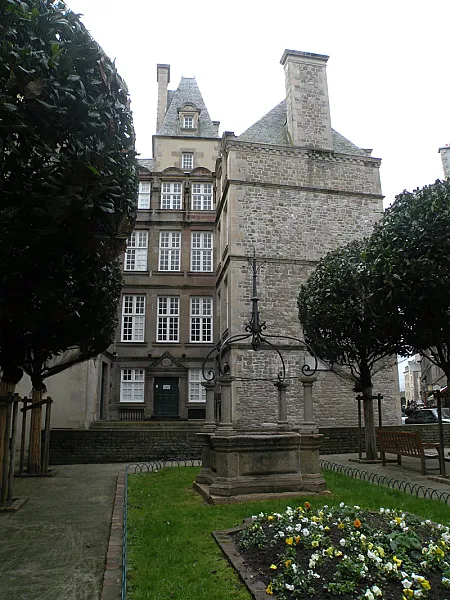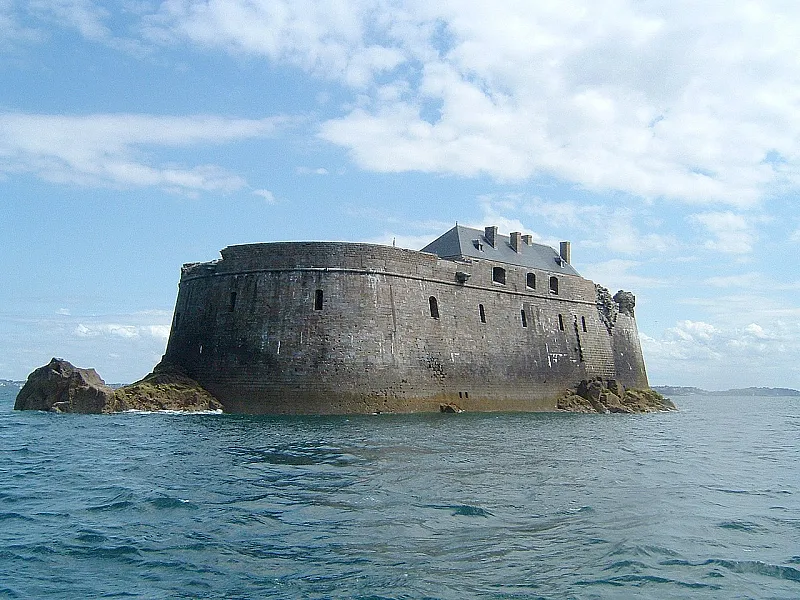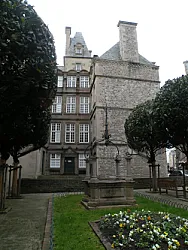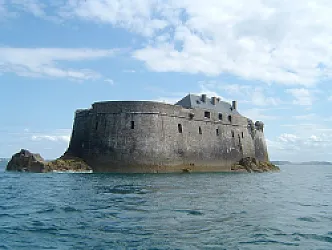Visit Saint-Malo in 2 days
6 must-see POIs, optimized routes and anecdotes.
Loading map...
You will visit the most beautiful points of interest in Saint-Malo
2 Days in Saint-Malo — A Weekend of Walls, Waves, and Wonder
Saint-Malo stole my heart the moment I climbed the ramparts and felt the Atlantic wind slap my face. This corsair city — often called the "City of Corsairs" — wears history on its stones and salt in its hair. Some say it's overrated, but I found it raw, honest, and impossibly beautiful. I’ve wandered its alleys at dawn and nursed a crepe while the tide pulled the world wide open beneath me.
Why visit Saint-Malo? Beyond postcard views and grand façades, the city hums with a mix of sea-salted grit and old-money charm. You’ll hear gulls and bells, taste buttery seafood and warm cider, and see sunlight stumble across ancient cobbles. My must-sees in this plan are Hôtel André Desilles, Holland Bastion, and La Conchée. Walking the ramparts feels like stepping into a novel. Expect salty air, echoing footsteps in narrow lanes, and moments that make you want to stop time.
Planning can feel overwhelming here. There is so much to explore that you could happily linger for weeks. I get it — you have limited time, and you want to make it count. That’s exactly why I crafted this short Saint-Malo itinerary for first-time visitors. Below, I’ll show you exactly how to spend 2 days in Saint-Malo to capture history, architecture, and the sea, without rushing through the soul of the place.
Key tip: Time your visit around the tides. The bay of Saint-Malo changes dramatically with the tide, and it shapes what you can see and do. Arrive early to enjoy quieter ramparts and clearer views of La Conchée. This small planning choice transforms crowds into calm, and haste into lingering. Now let’s dive into the itinerary!

Quick Mini Guide to Saint-Malo
Where to stay:
- Hôtel André Desilles — historic comfort inside the ramparts, ideal for wandering at dawn.
- Choose Intra-Muros for cobbled access to sights; Saint-Servan for calmer sea views and ferries.
When to visit:
- Check tide tables — low tide reveals beaches and paths to Grand Bé; high tide makes the sea forts dramatic.
- Late spring–early autumn for livelier terraces and longer daylight on the ramparts.
Things to do:
- Walk the granite ramparts, stop at Holland Bastion for coastal cannon placements and panoramic photos.
- Book a boat or shoreline view of La Conchée — the offshore fort built to guard the harbor; great at sunrise/sunset.
- Evening interactive mixology at The Alchemist SAINT-MALO — hands-on cocktail theatre suited to small groups.
- Savour fresh oysters and kouign-amann in local bistros and markets near the sea walls.
Don't forget:
- Waterproof layer and good shoes for slippery granite and cobbles.
- Reserve The Alchemist and any boat trips in advance; tide schedules affect access to sights.
Day 1 - Saint-Malo
3 POIs to discoverDay 1 - Morning à Saint-Malo
3 Points of interest - Duration : 2h15 - Distance : 4.4 km - Walking : 0h58
Hôtel André Desilles
- The Hôtel André Desilles is a 17th century granite mansion.
- The hotel was part of the original city wall.
- The building currently houses the municipal library.
- It is the birthplace of André Desilles, lieutenant of the Régiment du Roi-Infanterie.
- Inside, some original elements remain, such as a room that appears to have been used as a theater.
- The well in the courtyard comes from the former Hôtel-Dieu.

Holland Bastion
- Built in 1674, it was constructed to protect the town from an attack by Dutch fleets.
- Today, the gardens house a statue of Jacques Cartier, the Breton-French navigator and explorer commissioned by King François I.
- He reached the Gulf of St.
- Lawrence in 1534 and explored the surrounding territories, to which he gave the name "Canada".
- Cartier was the first European to describe and name this region and its inhabitants.

La Conchée
- La Conchée is a fortified rocky islet located offshore in the Bay of Saint-Malo, built by Vauban to protect Saint-Malo from English attacks.
- Saint-Malo was an active corsair center open to the English Channel, and Vauban decided to reinforce its defenses by building Fort de la Conchée, as well as other fortifications.
- Fort de la Conchée was built on two levels, with vaults and thick walls to protect the gunners.
- In 1695, during an Anglo-Dutch attack, Fort de la Conchée withstood the cannonballs and proved its effectiveness.
- After 1730, the fort was no longer directly attacked by enemy vessels.
- It suffered damage from storms and gunfire during the Second World War.
- The fort was demilitarized in 1889, abandoned for decades, and is currently being restored.
Day 2 - Saint-Malo
3 POIs to discoverDay 2 - Morning à Saint-Malo
3 Points of interest - Duration : 2h15 - Distance : 4.4 km - Walking : 0h58
Hôtel André Desilles
- The Hôtel André Desilles is a 17th century granite mansion.
- The hotel was part of the original city wall.
- The building currently houses the municipal library.
- It is the birthplace of André Desilles, lieutenant of the Régiment du Roi-Infanterie.
- Inside, some original elements remain, such as a room that appears to have been used as a theater.
- The well in the courtyard comes from the former Hôtel-Dieu.

Holland Bastion
- Built in 1674, it was constructed to protect the town from an attack by Dutch fleets.
- Today, the gardens house a statue of Jacques Cartier, the Breton-French navigator and explorer commissioned by King François I.
- He reached the Gulf of St.
- Lawrence in 1534 and explored the surrounding territories, to which he gave the name "Canada".
- Cartier was the first European to describe and name this region and its inhabitants.

La Conchée
- La Conchée is a fortified rocky islet located offshore in the Bay of Saint-Malo, built by Vauban to protect Saint-Malo from English attacks.
- Saint-Malo was an active corsair center open to the English Channel, and Vauban decided to reinforce its defenses by building Fort de la Conchée, as well as other fortifications.
- Fort de la Conchée was built on two levels, with vaults and thick walls to protect the gunners.
- In 1695, during an Anglo-Dutch attack, Fort de la Conchée withstood the cannonballs and proved its effectiveness.
- After 1730, the fort was no longer directly attacked by enemy vessels.
- It suffered damage from storms and gunfire during the Second World War.
- The fort was demilitarized in 1889, abandoned for decades, and is currently being restored.
Where to Stay in Saint-Malo
Location matters in Saint-Malo more than in many coastal towns because the experience here is defined by the ramparts, the sea and the tides. Choosing a base close to the old town means you wake up already inside the storybook streets, while staying a little farther out gives you quieter nights and broader sea views. Think about whether you want cobbled alleys on your doorstep or a promenade at sunrise — both are authentic, and both shape how you’ll spend your two days.
Saint-Malo is organized around its fortified center and the neighborhoods that bump up against the water. The compact, pedestrian-friendly Intra-Muros is where history and cafes live side by side; across the river the residential area of Saint-Servan feels more local and calm; and the long sandy promenades of Paramé offer the closest relationship with the open sea and views toward La Conchée. Because distances are short, you’ll find that a well-placed base lets you reach the main sights in minutes on foot.
If you want to be in the heart of the action, aim for accommodations near the ramparts where Hôtel André Desilles and the Holland Bastion anchor explorations of the old town — you can stroll from your room onto the ramparts at dawn. For gentler evenings and seaside walks toward views of La Conchée, look to Paramé or the stretch between Intra-Muros and Saint-Servan, where the sound of waves replaces late-night bustle. Wherever you land, a ten- to twenty-minute walk will put most attractions within easy reach.
Transport in Saint-Malo is straightforward: the town is very walkable, the train station links to regional lines, and local buses or taxis handle heavier luggage or late returns. Remember that parking inside the old walls is limited and many historic buildings have stairs and narrow corridors, so if mobility or bags are a concern, choose ground-floor rooms or properties with lift access. Also check tide times — the rhythm of the tides shapes when you can explore beaches and coastal forts, and it’s part of the charm here.
Finally, relax about your choice: whether you prioritize being inside the ramparts for atmosphere or a seafront room for views, you can tailor your stay to match your pace. Look for places that highlight proximity to the ramparts or promenade, ask about stairs and views, and know that Saint-Malo’s small scale makes it easy to switch plans on the fly — the right neighborhood will make your two days feel effortless and richly local.
Getting Around Saint-Malo
Saint-Malo is delightfully compact, which makes its bus network and walking routes a dream for visitors — you rarely need anything more complicated than a short ride or a pleasant stroll along the ramparts. The city centre, beaches and forts are clustered close together, and regional trains (the TER) link you easily to Rennes and nearby towns from the Gare de Saint-Malo. Public transport here feels uncomplicated: routes are short, signage is clear, and locals are used to helping tourists find the best way to get from point A to the ramparts or the harbour. 🗺️
Practicalities are simple: most services accept single tickets and there are usually multi-ride or day pass options if you plan to hop on and off. Buy on board from the driver or at kiosks near the main stops, and remember to validate your ticket when you board — validation machines are standard. Many places now accept contactless payment, so a card tap is often the fastest option, but I always keep a spare coin or two in case a machine is out of order. 🎫
Use Google Maps (or your preferred navigation app) to plan in real time: it shows bus timetables, walking times between the old town and the harbour, and train departures from the Gare. When I travel I check the app five minutes before leaving so I know whether to walk to the next stop or wait for the next vehicle, and the live updates save so much guessing. If a ferry or boat tour is involved — for example to visit sea forts — the app will also point you to the correct quay and give boarding times.
Money-wise, Saint-Malo rewards a little planning: pairing walking with short bus rides cuts costs, and a day pass is cheaper than several one-way fares if you plan to explore beyond the walled city. Also consider renting a bike for a half-day; it’s often inexpensive and gives you freedom to reach quieter beaches or viewpoints without multiple tickets. Small savings add up, and you get more time to enjoy the sea air.
I still smile remembering the day we left the Hôtel André Desilles, wandered along the ramparts to the Holland Bastion, then hopped down to the harbour where a friendly ticket agent pointed us to a short boat tour that took us out past La Conchée. We validated a simple ticket, followed Google’s walking directions between stops, and spent the afternoon switching effortlessly between walking, a short bus hop and a boat — easy, scenic and utterly memorable. 💡
What to Pack for Saint-Malo
Saint-Malo is a compact, salty, endlessly walkable city — the walled old town, the ramparts and the tidal beaches invite wandering. I’ve spent full days there, out for 8–10+ hours and once walked nearly 12 miles in a single day exploring every bastion and alley. Pack light but smart: everything should work for cobbled streets, sudden sea wind and a day that stretches longer than you expect.
1. Comfortable walking shoes (required — e.g., Merrell Moab or Ecco street runners): I learned this the hard way after a day on the ramparts in flimsy trainers — my feet ached for two days. The cobbles are uneven and you’ll climb stairs and steep slopes; a grippy, cushioned shoe with a stiff sole saved me when I tried a sturdier pair the next day. Why: pain-free walking means you see more (I walked 12 miles and didn’t regret a step).
2. Cross-body bag with secure zip and adjustable strap: I always carry a zippered cross-body that sits at my front when I’m on the ramparts. Saint-Malo is safe, but tourist spots attract minor opportunists and you’ll be distracted taking photos. Why: easy access, hands-free comfort and extra security — plus it’s practical when you’re juggling a map, camera and a crêpe.
3. Weather-appropriate layers — lightweight waterproof jacket and a warm mid-layer: One morning I left in a T‑shirt and was soaked by an Atlantic squall two hours later. Even in summer the wind off the bay cuts through you. Why: the climate changes fast; a packable waterproof and a fleece or merino layer keep you comfortable while you linger on the ramparts or wait for tidal views.
4. Power adapter (French Type E) and phone charger: France uses Type E plugs, 230V. I once had to borrow an adapter at a crowded café — awkward. Why: you’ll want to charge a phone for photos, maps and tide apps; a proper adapter avoids hunting for replacements mid-trip.
5. Power bank (10,000–20,000 mAh recommended): On a long exploration day I drained my battery taking photos of the sunrise over the bay and video on the ramparts. A 10,000 mAh power bank got me through one long day; 20,000 mAh is safer if you rely on your phone heavily. Why: no need to cut a walk short because your phone dies.
6. Optional — compact travel umbrella or small packable windproof umbrella: I keep a tiny umbrella in my bag for quick Atlantic showers; it’s folded and barely noticeable. Why optional: if you hate being wet, this saves you from soggy photos and damp souvenirs, but if you prefer a rain jacket you can skip it.
Enjoy Your Trip to Saint-Malo!
In two lively days you’ll explore three standout spots that capture Saint-Malo’s spirit: the elegant Hôtel André Desilles, the sea-swept Holland Bastion and the evocative tidal island La Conchée. This itinerary is packed with historic architecture, fortified walls and surprising viewpoints — everything you need for a memorable weekend by the sea, from coastal walks to quiet coffee breaks.
Remember, this is a guide, not a strict schedule: be flexible, wander the ramparts and leave room for the unexpected. The real magic often comes from getting pleasantly lost in narrow lanes, stumbling on a hidden plaque at Holland Bastion, or pausing for an unplanned snack near La Conchée. Don’t try to see everything — savor a few sights well and breathe.
I hope you feel excited and ready. I’m excited for you to walk the ramparts at sunset, taste coastal air and hear tides around La Conchée. You’re going to love the blend of history and sea — you’ll create unforgettable memories that stay with you long after you’ve left.
Want to explore in a playful way? Try Coddy’s gamified city tour, The Alchemist SAINT-MALO, for puzzles, local stories and hands-on discovery that bring the old walls to life. Check out our Coddy tours to add a fun, interactive twist to your two-day adventure.
Have an amazing trip and trust your instincts — take your time, ask questions and share your stories if you like. Safe travels!
Want more adventure?
Discover our urban escape games to transform your visit into an interactive adventure!














